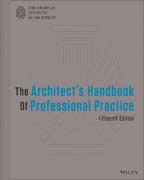
The Architect´s Handbook of Professional Practice
American Institute of Architects,
Authored by The American Institute of Architects (AIA), this guide is the updated architecture profession?s standard on practice issues. This indispensable resource covers all aspects of architectural practice, including legal, financial, marketing, management, and administrative issues. Content is significantly revised to reflect the changing nature of the business of architecture related to the impact of integrated practice. An accompanying web site contains samples of the latest AIA Contract Documents in PDF format. INDICE: Foreword vii Preface ix Acknowledgments xi About the 15th Edition of the Handbook xv PART 1 THE PROFESSION 1 1 Ethics and Professional Practice 2 1.1 The AIA Code of Ethics and Professional Conduct 2 1.2 Ethics and Architectural Practice 13 1.3 Design Beyond Ethics 19 2 Diversity and Demographics 27 2.1 Diversity and Practice Management 27 2.2 Demographics of Practice: 2012 AIA Firm Survey 36 3 Career Development 52 3.1 Regulation of Professional Practice 52 3.2 Intern Development 68 3.3 The Career Paths of an Architect 82 3.4 AIA Continuing Education System 93 3.5 Participating in Professional Organizations 99 3.6 Participating in Architectural Education 113 4 Public Interest Design 117 4.1 Socially Responsible Design Overview 117 4.2 The Role of Architects in Disaster Response and Recovery 131 4.3 Architects in the Nonprofi t Sector 147 4.4 Public Service and Community Involvement 156 PART 2 FIRM MANAGEMENT 167 5 Organizational Development 168 5.1 Architects and the Law 168 5.2 Entrepreneurial Practice: Starting an Architecture Firm 185 5.3 Strategic Planning for the Design Firm 203 5.4 Firm Growth and Development: How to Build a Creative Culture 216 5.5 Leader Effectiveness 227 5.6 Ownership Transitions 237 5.7 Small–Firm Collaboration 252 5.8 Practicing in a Global Market 262 5.9 Developing and Managing Multiple–Office Firms 275 5.10 Offi ce Administration 291 5.11 Knowledge Management 308 5.12 Information Management and Services 321 6 Marketing and Business Development 332 6.1 Marketing Architectural Services 332 6.2 Developing Marketing Strategy 342 6.3 Public Relations and Communications 355 6.4 Networking and Business Development 370 6.5 Qualifi cations, Proposals, and Interviews 381 7 Financial Management 396 7.1 Navigating Economic Cycles 396 7.2 Financial Management Overview 409 7.3 Financial Management Systems 418 7.4 Developing Annual Budgets and Profit Planning 428 8 Human Resources 444 8.1 Human Resources Management Overview 444 8.2 Compensation Strategy and Philosophy 461 8.3 Recruiting and Hiring: Strategies and Methodology 475 8.4 Professional Development and Mentoring 487 PART 3 PROJECT DELIVERY 507 9 Design Project Delivery 508 9.1 Project Delivery Methods 508 9.2 The Architect’s Role in Construction Manager–Constructor Project Delivery 520 9.3 Integrated Project Delivery Overview 530 9.4 Contractor–Led Design–Build 541 9.5 Architect–Led Design–Build 555 9.6 Architect Developer 563 9.7 Emerging Issues in Project Delivery 577 10 Design Project Management 584 10.1 Managing Architectural Projects 584 10.2 Project Teams 603 10.3 Project Budgets, Work Planning, and Monitoring 621 10.4 Project Management with Building Information Modeling Processes 641 10.5 Design Phases 654 10.6 Construction Drawings 668 10.7 Construction Specifi cations 689 10.8 Bidding and Negotiation 701 10.9 Construction Phase Services 713 10.10 Project Completion and Post–Construction 729 11 Technology in Practice 740 11.1 Technology in Practice Overview 740 11.2 Technology in Project Delivery Phases 754 11.3 Small Firms, Small Projects, and Building Information Modeling 764 11.4 Collaborative Technologies 780 11.5 Technology Management 785 11.6 Emerging Technology in Practice 798 12 Quality Management 810 12.1 Origins and Development of Quality Management 810 12.2 Quality Management in Schematic Design 822 12.3 Checklists 833 12.4 Quality Management in Construction Procurement, Contract Administration, and Post–Construction 847 13 Building Codes, Standards, and Regulations 857 13.1 Building Codes and Standards 857 13.2 Planning, Urban Design, and the Regulatory Environment 880 14 Research in Practice 899 14.1 Research in Practice Overview 899 14.2 Research Methods 911 14.3 Research and Practice 920 14.4 Evidence–Based Design 937 PART 4 CONTRACTS AND AGREEMENTS 951 15 Project Definition 952 15.1 Defi ning Project Services 952 15.2 Services and Compensation 961 15.3 Negotiating Agreement 975 16 Risk Management 989 16.1 Risk Management Strategies 989 16.2 Insurance Coverage for Business and Professional Liability 1007 16.3 Risks and Emerging Practices 1021 16.4 Dispute Management and Resolution 1030 17 Agreements and AIA Document Program 1040 17.1 Agreements with Owners 1040 17.2 Project Team Agreements 1055 17.3 Owner–Generated Agreements 1070 17.4 Construction Contracts 1083 17.5 The AIA Documents Program 1093 Appendix A: Allied Professional Organizations 1113 Appendix B: Glossary 1117 Index 1141 About the Companion Website 1166
- ISBN: 978-1-118-30882-0
- Editorial: John Wiley & Sons
- Encuadernacion: Cartoné
- Páginas: 1184
- Fecha Publicación: 18/12/2013
- Nº Volúmenes: 1
- Idioma: Inglés
